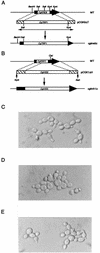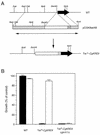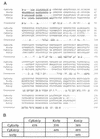Isolation of Candida glabrata homologs of the Saccharomyces cerevisiae KRE9 and KNH1 genes and their involvement in cell wall beta-1,6-glucan synthesis
- PMID: 9748432
- PMCID: PMC107535
- DOI: 10.1128/JB.180.19.5020-5029.1998
Isolation of Candida glabrata homologs of the Saccharomyces cerevisiae KRE9 and KNH1 genes and their involvement in cell wall beta-1,6-glucan synthesis
Abstract
The Candida glabrata KRE9 (CgKRE9) and KNH1 (CgKNH1) genes have been isolated as multicopy suppressors of the tetracycline-sensitive growth of a Saccharomyces cerevisiae mutant with the disrupted KNH1 locus and the KRE9 gene placed under the control of a tetracycline-responsive promoter. Although a cgknh1Delta mutant showed no phenotype beyond slightly increased sensitivity to the K1 killer toxin, disruption of CgKRE9 resulted in several phenotypes similar to those of the S. cerevisiae kre9Delta null mutant: a severe growth defect on glucose medium, resistance to the K1 killer toxin, a 50% reduction of beta-1,6-glucan, and the presence of aggregates of cells with abnormal morphology on glucose medium. Replacement in C. glabrata of the cognate CgKRE9 promoter with the tetracycline-responsive promoter in a cgknh1Delta background rendered cell growth tetracycline sensitive on media containing glucose or galactose. cgkre9Delta cells were shown to be sensitive to calcofluor white specifically on glucose medium. In cgkre9 mutants grown on glucose medium, cellular chitin levels were massively increased.
Figures







Similar articles
-
The KNH1 gene of Saccharomyces cerevisiae is a functional homolog of KRE9.Yeast. 1996 Jun 15;12(7):683-92. doi: 10.1002/(SICI)1097-0061(19960615)12:7%3C683::AID-YEA959%3E3.0.CO;2-8. Yeast. 1996. PMID: 8810042
-
The yeast KRE9 gene encodes an O glycoprotein involved in cell surface beta-glucan assembly.Mol Cell Biol. 1993 Oct;13(10):6346-56. doi: 10.1128/mcb.13.10.6346-6356.1993. Mol Cell Biol. 1993. PMID: 8413233 Free PMC article.
-
The Candida albicans KRE9 gene is required for cell wall beta-1, 6-glucan synthesis and is essential for growth on glucose.Proc Natl Acad Sci U S A. 1998 Aug 18;95(17):9825-30. doi: 10.1073/pnas.95.17.9825. Proc Natl Acad Sci U S A. 1998. PMID: 9707560 Free PMC article.
-
A mutational analysis of killer toxin resistance in Saccharomyces cerevisiae identifies new genes involved in cell wall (1-->6)-beta-glucan synthesis.Genetics. 1993 Apr;133(4):837-49. doi: 10.1093/genetics/133.4.837. Genetics. 1993. PMID: 8462845 Free PMC article.
-
A novel yeast gene, RHK1, is involved in the synthesis of the cell wall receptor for the HM-1 killer toxin that inhibits beta-1,3-glucan synthesis.Mol Gen Genet. 1997 Mar 26;254(2):139-47. doi: 10.1007/s004380050401. Mol Gen Genet. 1997. PMID: 9108275
Cited by
-
Remodeling of the Candida glabrata cell wall in the gastrointestinal tract affects the gut microbiota and the immune response.Sci Rep. 2018 Feb 20;8(1):3316. doi: 10.1038/s41598-018-21422-w. Sci Rep. 2018. PMID: 29463799 Free PMC article.
-
Portrait of Matrix Gene Expression in Candida glabrata Biofilms with Stress Induced by Different Drugs.Genes (Basel). 2018 Apr 10;9(4):205. doi: 10.3390/genes9040205. Genes (Basel). 2018. PMID: 29642649 Free PMC article.
-
Generational distribution of a Candida glabrata population: Resilient old cells prevail, while younger cells dominate in the vulnerable host.PLoS Pathog. 2017 May 10;13(5):e1006355. doi: 10.1371/journal.ppat.1006355. eCollection 2017 May. PLoS Pathog. 2017. PMID: 28489916 Free PMC article.
-
Inner kinetochore of the pathogenic yeast Candida glabrata.Eukaryot Cell. 2004 Oct;3(5):1154-63. doi: 10.1128/EC.3.5.1154-1163.2004. Eukaryot Cell. 2004. PMID: 15470243 Free PMC article.
-
Lessons on fruiting body morphogenesis from genomes and transcriptomes of Agaricomycetes.Stud Mycol. 2023 Jul;104:1-85. doi: 10.3114/sim.2022.104.01. Epub 2023 Jan 31. Stud Mycol. 2023. PMID: 37351542 Free PMC article.
References
-
- Aisner J, Schimpff S C, Sutherland J C, Young V M, Wiernik P H. Torulopsis glabrata infections in patients with cancer: increasing incidence and relationship to colonization. Am J Med. 1976;61:23–28. - PubMed
Publication types
MeSH terms
Substances
Associated data
- Actions
- Actions
LinkOut - more resources
Full Text Sources
Other Literature Sources
Molecular Biology Databases

